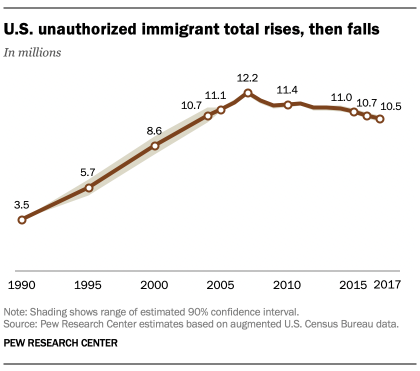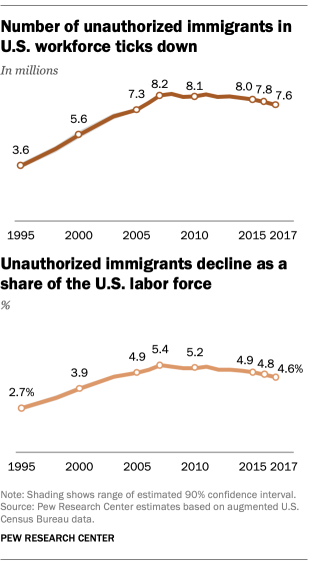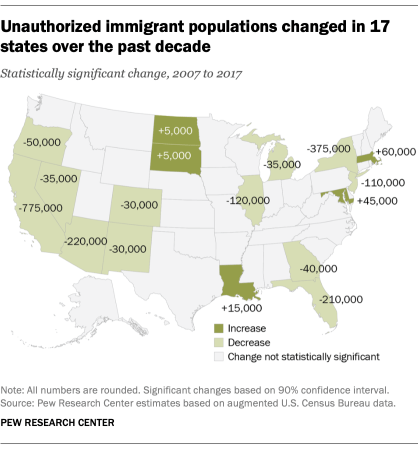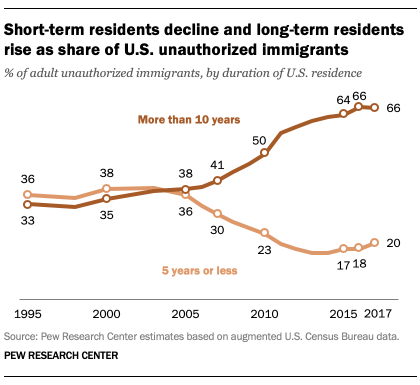Note: For more recent information on this topic (2023), visit this post.
The number of unauthorized immigrants living in the United States has dropped to the level it was in 2004, and Mexicans are no longer a majority of this population. This decline is due mainly to a large drop in the number of new unauthorized immigrants, especially Mexicans, coming into the country. The origin countries of unauthorized immigrants also shifted during that time, with the number from Mexico declining and the number rising from Central America and Asia, according to the latest Pew Research Center estimates.
Here are five facts about the unauthorized immigrant population in the U.S.
There were 10.5 million unauthorized immigrants in the U.S. in 2017, representing 3.2% of the total U.S. population that year. The 2017 unauthorized immigrant total is a 14% drop from the peak of 12.2 million in 2007, when this group was 4% of the U.S. population.
The number of Mexican unauthorized immigrants declined since 2007, while the total from other nations ticked up. Mexicans made up less than half of all unauthorized U.S. immigrants (47%) in 2017 for the first time, according to the Center’s estimate, compared with 57% in 2007. Their numbers (and share of the total) have been declining in recent years: There were 4.9 million Mexican unauthorized immigrants living in the U.S. in 2017, down from 6.9 million in 2007.
[callout align=”alignright”]
Try our email course on immigration
Learn about U.S. immigration through five short lessons delivered to your inbox every other day.
Sign up now!
[/callout]
Meanwhile, the total from other nations, 5.5 million in 2017, ticked up from 2007, when it was 5.3 million. The number of unauthorized immigrants has grown since 2007 from both Central America and Asia. There were 1.5 million Central American unauthorized immigrants in 2007 and 1.9 million in 2017. This growth was fueled mainly by immigrants from the Northern Triangle nations of El Salvador, Guatemala and Honduras. The number from Asia, 1.3 million in 2007, rose to 1.5 million in 2017.
At the same time, the number of unauthorized immigrants from South America and Europe decreased between 2007 and 2017. Other large regions (the Caribbean, Middle East-North Africa, sub-Saharan Africa and the rest of the world) did not change significantly during that time.
The U.S. civilian workforce includes 7.6 million unauthorized immigrants, representing a decline since 2007. Between 2007 and 2017, the number of unauthorized immigrant workers fell by 625,000, as did their share of the total U.S. workforce over the same period. In 2017, this group accounted for 4.6% of those in the U.S. who were working or were unemployed and looking for work.
Six states account for 57% of unauthorized immigrants: California, Texas, Florida, New York, New Jersey and Illinois. From 2007 to 2017, individual states experienced different trends. The unauthorized immigrant population decreased in a dozen states: Arizona, California, Colorado, Florida, Georgia, Illinois, Michigan, Nevada, New Jersey, New Mexico, New York and Oregon. In five states, the unauthorized immigrant population rose over the same period: Louisiana, Maryland, Massachusetts, North Dakota and South Dakota.
A rising share of unauthorized immigrants have lived in the U.S. for more than a decade. About two-thirds (66%) of unauthorized immigrant adults in 2017 had been in the U.S. more than 10 years, compared with 41% in 2007. A declining share of unauthorized immigrants have lived in the U.S. for five years or less – 20% of adults in 2017, compared with 30% in 2007. In 2017, unauthorized immigrant adults had lived in the U.S. for a median of 15.1 years, meaning that half had been in the country at least that long.
Note: This is an update to a post originally published on Nov. 18, 2014.







